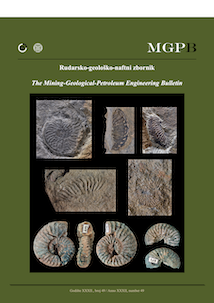An investigation into fracture toughness and mechanisms in anisotropic rocks using the Acoustic Emission method
DOI:
https://doi.org/10.17794/rgn.2020.2.2Keywords:
Acoustic emission, anisotropic rock failure, fracture toughness, fracture mechanismAbstract
Anisotropy in rock is among the important parameters that should be considered in studying fracture toughness and fracture mechanisms. Acoustic emission is one of the methods applied to investigate fracture mechanics and how micro- cracks grow in rock samples. This method can help to identify different parts of stress versus strain curves. Using this method, the current research aims to study the effect of anisotropy angles on fracture toughness and fracture mecha- nisms of rock samples. To study the designated parameters, the Cracked Chevron Notched Brazilian Disc (CCNBD) method was selected. Blocks of slate, as an anisotropic rock, were prepared from the Sanandaj-Sirjan zone in Iran. The sample sizes were 54 mm and 74 mm in diameter and 24 mm and 37 mm in thickness, respectively, and their anisotropy angles were 0°, 15°, 30°, 45°, 60°, 75°, and 90°. The tests were carried out in accordance with the method suggested by the International Society for Rock Mechanics (ISRM). Two acoustic sensors were mounted on the specimens to log acoustic waves and determine the acoustic parameters (rise angle and average frequency) for fracture mechanism analysis. About 10 tests were carried out for each angle of anisotropy. Based on the obtained results, it was inferred that anisotropy affects the strength and fracture toughness of rock samples. By increasing the anisotropy angle from 0° to 30°, the strength and fracture toughness decreased. Exceeding this range of angle, with an increase in the anisotropy angle, the strength and fracture toughness increased as well.
Downloads
Published
How to Cite
Issue
Section
License
Copyright (c) 2020 authors and journal

This work is licensed under a Creative Commons Attribution 4.0 International License.
Creative Commons-BY
Authors who publish with this journal agree to the following terms:
In agreeing this form, you certify that:
- You read the ethical codex of the RGN zbornik available at journal web.
- You submitted work is your original work, and has not previously been published and does not include any form of plagiarism.
- You own copyright in the submitted work, and are therefore permitted to assign the licence to publish to RGN zbornik.
- Your submitted work contains no violation of any existing copyright or other third party right or any material of an obscene, libellous or otherwise unlawful nature.
- You have obtained permission for and acknowledged the source of any illustrations, diagrams or other material included in the work of which you are not the copyright owner.
- You have taken due care to ensure the accuracy of the work, and that, to the best of your knowledge, there are no false statements made within it.
- All co-authors of this submitted work are aware of, and in agreement with, the terms of this licence and that the submitted manuscript has been approved by these authors.
Publication licence
You retain copyright in your submitted work, according to journal license policy (CC-BY). By signing this form you agree that RGN zbornik may publish it under the publication licence. In summary the licence allows the following:
Anyone is free:
- To copy, distribute, display, and perform the work.
- To make derivative works.
Under the following conditions:
- The original author must always be given credit.
- The work may not be used for commercial purposes.
- If the work is altered, transformed, or built upon, the resulting work may only be distributed under a licence identical to this one.
Exceptions to the licence
In addition to publishing the work printed under the above licence, RGN zbornik will also enable the work to be visible online.
The journal editorial can change the licence rules anytime but it cannot retroactively restrict author(s) rights.


